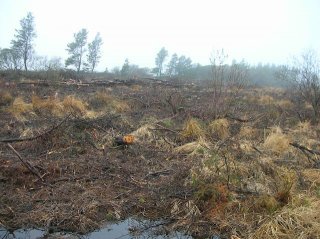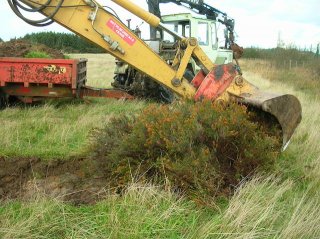On The Lizard we can still enjoy relatively large expanses of heathland on a truly landscape scale. They are world famous for their unique assemblage of plants and animals and have been on the botanist’s ‘must see’ list at least since John Ray, the ‘Father of English botany’, made the first botanical record here in 1667. He discovered ‘Juniper or Firre-leaved heath (Cornish heath) by the wayside going from Helston to Lizard Point’.
 An area of previously dense conifer plantation that has been felled to allow the restoration of a mosaic of heathland habitats including heath, scrub, tracks and ponds.
An area of previously dense conifer plantation that has been felled to allow the restoration of a mosaic of heathland habitats including heath, scrub, tracks and ponds.
Since then the fortunes of the heathlands have waxed and waned over the centuries, depending on their uses for alternative crops such as ploughing to form ‘lazy-beds’, quarrying and more recently for conifer plantations, airfield construction and improving pasture for dairying and beef production. Indeed studies have concluded that many of the enclosed heathland areas have been ploughed at some time or another, with the maximum extent of agricultural utilisation probably occurring prior to the repeal of the Corn Laws in the early 1800s.
The present day sees virtually all of the existing heathland area protected from further loss through the national designation as Sites of Special Scientific Interest and the European Special Area of Conservation. The task now is to ensure these sites are not only managed favourably to ensure their special features are conserved but also to take a landscape-wide view of where their biodiversity value can be enhanced. If landowners are willing to consider this approach, there are payment options available under Environmental Stewardship to help with the costs of restoration and re-creation of heathland. A range of management techniques can be used depending on the past history of the land and there are currently over 75 hectares of land, mostly around the periphery of Goonhilly Downs, where a mosaic of heathland habitats are being re-created under this scheme. Seed-bearing heather turves being translocated into an agriculturally improved grassland as the first stage in restoration to heathland.
Seed-bearing heather turves being translocated into an agriculturally improved grassland as the first stage in restoration to heathland.
Where the land has been planted with conifers (often an experimental crop that invariably has failed to produce a timber crop on The Lizard due to its waterlogged soils, windblow and/or fire over the decades), removal of the trees will re-expose soil and vegetation that is quite readily amenable to recovery as heathland. Where forested sites have developed as a wildlife-rich habitat or a tree canopy is an important element in the local landscape, then the removal of conifers needs to be carefully considered as a part of a wider management plan.
However, the re-creation of heathland vegetation on recently improved pasture is proving to be much more difficult and time consuming, mainly due to the considerable modification of the soil structure, its chemical status and drainage patterns during the process of agricultural improvement. Although experimental at this stage, methods including the translocation of heathland turves, spreading of seed-bearing litter and long term grazing are all currently being undertaken on different sites.
Published: Dec 2013
Author: Jeremy Clitherow (Lead Adviser for Natural England’s Cornwall & Isles of Scilly Land Management Team)
Click
here for more articles about conservation work on the Lizard.
 An area of previously dense conifer plantation that has been felled to allow the restoration of a mosaic of heathland habitats including heath, scrub, tracks and ponds.
An area of previously dense conifer plantation that has been felled to allow the restoration of a mosaic of heathland habitats including heath, scrub, tracks and ponds. Seed-bearing heather turves being translocated into an agriculturally improved grassland as the first stage in restoration to heathland.
Seed-bearing heather turves being translocated into an agriculturally improved grassland as the first stage in restoration to heathland.